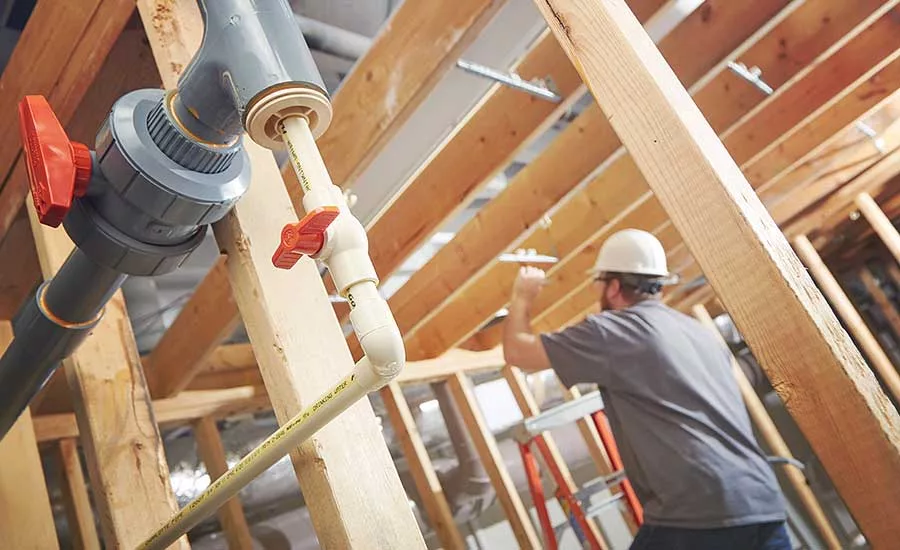Best practices for CPVC installation
Follow these solvent-welding steps to properly install a reliable CPVC plumbing system.

CPVC plumbing systems have been used for decades in residential plumbing systems and are becoming increasingly popular in larger commercial plumbing applications. CPVC pipes and fittings are joined using a fast and reliable solvent welding process that produces a unique connection that is the strongest point of the system surpassing the strength of pipe and fitting individually.
UNDERSTAND THE CPVC MATERIAL OPTIONS
There are two distinct types of CPVC plumbing systems available on the market today:
Copper Tube Size (CTS) SDR 11 CPVC Pipe and Fittings: Ideal for residential plumbing applications, CTS SDR 11 CPVC is typically tan in color and is produced in ½-inch to 2-inch diameters. Engineers and plumbing contractors commonly, but mistakenly, refer to this system as Schedule 40 CPVC, however a CTS SDR 11 system offers many benefits over a Schedule 40 dimension including the ability to maintain constant pressure and temperature ratings at all diameters.
Iron Pipe Size (IPS) Schedule 80 CPVC Pipe and Fittings: Best suited for larger commercial projects, IPS Schedule 80 CPVC is typically light gray in color and is produced in ¼-inch to 24-inch diameters. Because Schedule 80 CPVC has the same dimensions as Schedule 80 PVC, it is important to avoid mixing components; Schedule 80 PVC will typically be a much darker gray than Schedule 80 CPVC.
THE DO’S AND DON’TS
-
Use the correct tools. For cements and primers, ensure that the dauber size is 50-100% of the nominal diameter of the pipe for pipes 3 inches and smaller. For pipes 4 inches and larger, an appropriate swab or roller should be used. Avoid scissor-type cutters as these are not designed for hard pipe and may cause damage to either the pipe or the tool.
-
Avoid dry fits. Dry fit is simply putting a pipe and fitting together without applying solvent cement. Some installers will do this to layout the system before welding it. However, it’s easy to lose track of which joints may have been dry fitted. Do not pre-assemble the plumbing system without solvent cement; this increases the risk of dry-fit failures. To assist in detecting dry-fits, some manufacturers produce solvent cements with UV indicators that will glow under a black light. Completing a pressure test can also help detect dry-fits. The pressure test should always be conducted hydrostatically (with water) in accordance with local codes; however, testing at pressures greater than 100psi can be used to significantly improve the chance of finding a dry-fit during a test.
-
Apply solvent cement properly. Ensure proper coverage of cement on the pipe and fitting; too little solvent cement can result in gaps and leak paths. Excessive solvent cement, leading to puddling of cement with the system, may damage the integrity of the system and should be avoided.
-
Bottom out on assembly. When inserting a solvent cemented pipe into a fitting, the pipe should bottom out against the fitting. If there is no difference between the insertion depth during the fit check step and assembly, the joint will not be properly completed. To help ensure this occurs, properly make sure the pipe has been cut squarely and chamfered prior to the proper application of solvent cement.
-
Account for pipe movement. CPVC will expand about 1 inch per 50 feet of straight length of pipe per 50° F temperature increase. Accommodate expansion and contraction using expansion loops, offsets, and changes of direction. Do not restrict the natural, lateral movement of the pipe and fittings; this includes avoiding the use of restricting hangers or restraints near the joints used to accommodate expansion as well as leaving adequate space between the expansion loop and any fixed structure.
-
Use proper freeze protection. Even in traditionally warm weather climates, builders and contractors should expect freezing temperatures at some point in the life of the building. All piping should be protected against freezing in accordance with local code requirements, and piping should never be installed in uninsulated portions of a building without freeze protection.
NON-SOLVENT CEMENT-JOINING METHODS
Along with solvent weld methods, there are now cut-groove mechanical joining options for Schedule 80 CPVC systems 2-12 inches. To learn more about mechanical joining methods and for additional engineering resources, visit www.corzanplumbing.com/design-installation. To learn more about solvent welding installation methods, visit www.flowguardgold.com/installPM.
Looking for a reprint of this article?
From high-res PDFs to custom plaques, order your copy today!








